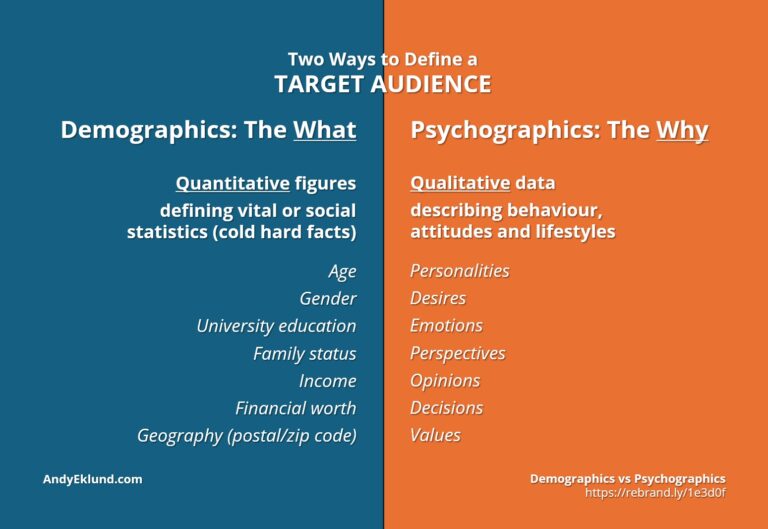Defining the target audience falls into two types of statistical data:
- Demographics
- Psychographics, including Values
Both are valuable ways of understanding a specific audience and conducive to brainstorming solutions, but not in the same way.
Demographics: The What
Oftentimes the “easier” of the two types to define, demographics are quantitative figures defining vital or social statistics.
In other words, they’re cold, hard facts. Such as:
- Age
- Gender
- University education
- Family status
- Income
- Financial worth
- Geography (using their postal or zip code for example)
Demographics is helpful initially to define the group, but you should not only rely on them. In fact, it’s hard to work creatively with demographics as they tend to exclude people rather than include them.
For example, one client told me: “Oh, that audience is too old for our product.” The product was face cream, not something exceptional to one’s age. In other words, ‘age’ was used as a discriminatory aspect. I said, “Do you really care if the person who purchases your product is 16 or 60?” And yes they do, but mostly to buy the right advertising space.
If demographics define the what, the next type defines something more interesting, the why.
Psychographics: The Why
Psychographics are qualitative data that studies an audience’s behaviour, attitudes and lifestyle choices.
It studies and measures:
- Personalities
- General attitudes
- Behaviours and lifestyle choices
- Desires
- Emotions
- Perspectives
- Opinions
- Decisions
- Values
They are not specific to a particular company, product, service, brand, or category. In marketing and opinion research, they help an organisation understand consumer preferences, if not predict behaviour. Using the face cream case from above, two examples of psychographics were:
- Interested in new technology for skin care (new chemical formulations other cosmetics weren’t using yet)
- Concerned about the environment (they were not animal tested, didn’t use ingredients from rain forests)
Psychographics are inclusionary because people select themselves into categories, such as being concerned about the environment. In this way, psychographics are far more useful for ideation.
It’s not to say demographics can’t be useful in brainstorming, just in different ways. For example, you and your neighbours live in the same postal/zip code, but that doesn’t necessarily mean you’re alike. However, for political campaigns which run by where you vote, demographics would be extremely helpful.
Suffice to say, if you want a complete profile of an audience, combine both demographics and psychographics together.
Values
Although a subset of psychographics, values are the most significant way to understand an audience, particularly to help predict behaviour.
Values are deeply rooted principles or standards which are universally accepted among the target audience, and explicitly guide what they believe and their attitude toward a specific topic, and ultimately how they behave.
There are many different lists of values, but (as you can imagine) defining precisely the values that everyone taps into to make decisions is impossible. These lists can range in size. A more detailed view of values is , and the specific list is in a second post . I fully admit I use it because it’s one of the shortest at 22 different clues.
As a simplified example of all three types together, see Bruce & Sheila at the bottom of this post. (Giving your audience a name as it were, is part of a persona.)
A Few Key Points Here
First and foremost, never guess or choose. Never make any assumption either. If you can’t quantify it with research, either in person or through secondary sources, don’t consider it true. The absolutely best way to get the answer is to ask them directly. (Research gathered directly from the source is Primary Research.)
Psychographics are far more important than Demographics. Facts alone never convinced anyone to do anything. Consider the why behind what people believe, their attitudes and behaviours, and most of all, their actions. What motivates them? What scares them? When you understand deeply why the consumer thinks and acts the way they do, you’ll be more likely to convince them to do or consider something different.
Speak to as many of your end users as possible. Think of all your open questions in advance. Only ask questions, never make a statement. Never talk about yourself or offer your opinion.
Spend as much time, energy, and money as possible to get accurate and relevant information. There are many ways to gather it. I’ve listed a few below.
- If your organisation produces any type of research, it’s very likely they have some basic information about your key audiences.
- If your organisation produces advertising, it’s very likely the ad agency – or similar external consultant – will have this information.
- There are a plenty of online tools to gather data about audiences. But, check their gathering processes to ensure you’re getting something valid. You can use websites to create your own surveys to gather relevant information. (Again, make sure you’re getting information from the right type of people.)
- You can also get quality information about the target audience the old-fashioned way: talk to them. In fact, when was the last time you physically spent time talking with the audience you’re trying to reach?
A Simplified Example of Demographics and Psychographics
Bruce & Sheila: Wine Drinkers in Australia
Demographics
- Between 35-44 years-of-age
- Equal male/female
- Caucasian (93%)
- Married (84%)
- Household Incomes $65K-$150K (63%)
- Managerial or professionals
- Graduate degrees (39%)
- Own residence (62%)
- One or more child (73%)
Psychographics
- ‘Aspirers’ – people who aspire to more than they have now, who see themselves as a step above the mainstream
- Good opinion of self; seeks to improve self
- Amiable, benevolent, self-assured, gracious, sophisticated, and creative
- Class/status conscious
- Somewhat experimental
- Loves going to favourite restaurants, venues, pubs
- Active in social activities, kids’ activities
- Enjoys eating foreign food and trying new food products
- Enjoys entertaining at home by the BBQ
- Believes worth paying extra for quality
- Usually buys wine by brand name, but not above shopping by price
Values
- Accomplishment: The wine I serve says everything about me, our success
- Belonging and Acceptance: I want to be seen as knowledgeable, so I can impress my friends
More information about Demographics and Psychographics is here: How to Use Psychographics in Marketing: A Beginner’s Guide.
A secondary article about Values is Defining The Target Audience by Their Values. The specific list of universal values is here.
Any additional thoughts on how you’ve used Demographics vs Psychographics in the past? Please add your thoughts and comments below.



No comment yet, add your voice below!